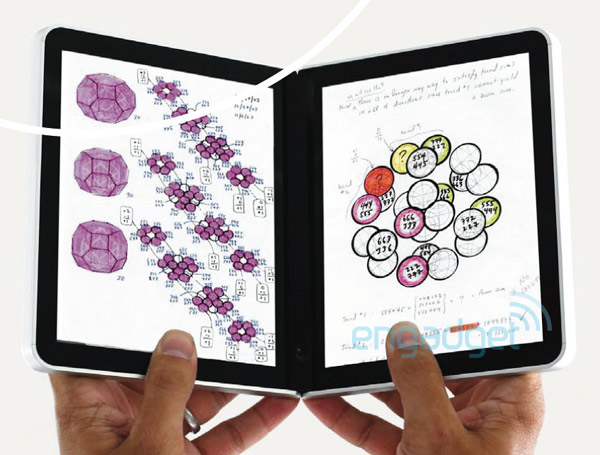 I can’t help but sigh whenever I hear more details about Microsoft’s ill-fated Courier tablet.
I can’t help but sigh whenever I hear more details about Microsoft’s ill-fated Courier tablet.
The latest tidbits on the Courier debacle come from CNet’s Jay Greene, who interviewed 18 current and former Microsoft execs, along with others working on the project, to give us our most complete look at why the innovative project was killed off.
Before the first iPad was announced, the gadget site Gizmodo reported that Microsoft was working on a tablet with dual 7-inch screens, vaguely resembling a Moleskin notebook. Microsoft was positioning the device as a digital journal that featured a pen-based and multitouch interface, and it would have also made a compelling e-reader — a market the company still hasn’t touched.
As Greene tells it, Microsoft was pursuing two different tablet strategies long before the iPad was officially unveiled. There was the Courier, spearheaded by the two biggest minds behind the Xbox, J Allard and Robbie Bach, and a more traditional Windows-based tablet project led by Steven Sinofsky, head of the Windows division.
To help him decide which project to back, Microsoft CEO Steve Ballmer enlisted Bill Gates’ wisdom. Writes Greene:
At one point during that meeting in early 2010 at Gates’ waterfront offices in Kirkland, Wash., Gates asked Allard how users get e-mail. Allard, Microsoft’s executive hipster charged with keeping tabs on computing trends, told Gates his team wasn’t trying to build another e-mail experience. He reasoned that everyone who had a Courier would also have a smartphone for quick e-mail writing and retrieval and a PC for more detailed exchanges. Courier users could get e-mail from the Web, Allard said, according to sources familiar with the meeting.
Allard went on to describe the Courier as a PC complement, instead of a replacement, and that its users wouldn’t need an extensive e-mail application like Outlook. That response led to an “allergic reaction” by Gates, according to a former Courier worker. Several weeks later, Microsoft cancelled the project because it didn’t fully mesh with its Windows and Office plans, sources say.
Now Microsoft is putting its weight behind Windows 8 for tablets, which will start appearing next year. But even though Windows 8 looks interesting, it’s undeniably a rehash of the iPad, whereas the Courier would have been something completely different and, notably, released around the time of the first iPad.
While there’s certainly more to the story (the second part of Greene’s piece is coming tomorrow), Gates’ initial reaction seems fairly indicative of why the Courier didn’t survive. When faced with the choice of something new and innovative, versus something that ties back into Microsoft’s massive software empire, it seems the company will always choose the latter.
The core ethos behind the Courier was “free create”, which is described as “a natural way to digitally write, sketch and gather inspiration by blending the familiarity of the pen, the intuition of touch, the simplicity of the book and the advantages of software and services,” according to an internal Microsoft book about the project.
Indeed, it’s not surprising that such a lofty philosophy failed to click within Microsoft — I just hope there’s some company out there that can follow through with that initial vision. There’s definitely still plenty of value with the notion of a completely digital notebook.
Writing about the Courier’s death in April, I said “Most likely a future Microsoft tablet will look similar to the iPad, come out several years too late, and nobody will take it seriously.” Yup.
Image via Engadget

